#balliol
Explore tagged Tumblr posts
Text
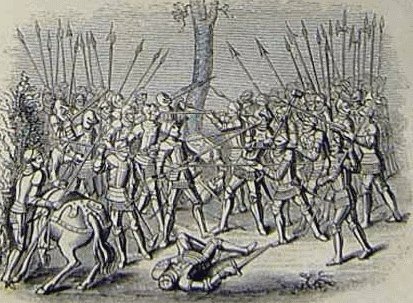
On December 25th in the year 1319 a two year truce between Scotland and England began.
This little known peace treaty is often overlooked, probably due to the Bruce’s government issuing the Declaration of Arbroath the following year.
After Bannockburn King Edward II of England never forgot his humiliation, and he threatened war against Scotland. The Bruce got there first, raiding south as far as York in a bid to capture prisoners to be held for ransom. Edward also had his troubles at home with a trebellion.
The King was also talking to some of the great Northern lords and it looked as if they would do a separate deal with the Bruce to stop him destroying their land. Thomas, Earl of Lancaster, was one of the rebel barons but paid for it with his life after the Battle of Boroughbridge was won by forces loyal to Edward.
Encouraged by ending the civil war in England, Edward came north with a great army, but Bruce deployed the same tactics he had used prior to Bannockburn, destroying anything that could be of use to the English, who were forced to retreat when famine and disease broke out.
In September 1319 The Bruce won a decisive battle at Myton in Yorkshire
Earlier that year Edward II had moved an army North and laid siege to Berwick in an attempt to recapture it from the Scots. In response the army of several thousand Scots, commanded by the Earl of Moray and the Good Sir James Douglas, bypassed the Northern town and marched through the north of England torching all in their path. Their secret objective lay in Edward’s court at York; where they hoped to abduct Edward II’s wife, the 21 year old Queen, Isabella. On September 20th 1319 they neared York and The Battle of Myton ensued.
The outcome of this unequal contest was never in doubt. Formed up according to their custom in a single division, the Scots uttered together a tremendous shout to terrify the English, the Highland charge began racing towards the men from York, who straightaway began to take to their heels at the sound.
The York contingent was an odd mixture of men thrown together to meet the emergency, including priests and monks losses were reported of 3,000, among them Nicholas Flemyng the city mayor.
For Edward II, already at odds with many English nobles, it was another disaster. Meanwhile the victorious Scottish army retreated back across the border into Scotland carrying their ill-gotten gains and prisoners.
Afterwards Edward was forced to raise the siege of Berwick and ultimately agreed to a two year truce.
193 notes
·
View notes
Photo

Robert the Bruce
Robert I of Scotland, better known as Robert the Bruce, reigned as King of Scotland from 1306 to 1329 CE. For his role in achieving independence from England, Robert the Bruce has long been regarded as a national hero and one of Scotland's greatest ever monarchs.
Robert succeeded John Balliol (r. 1292-1296 CE) but only after a tumultuous decade of side-switching and military ups and downs against English armies led by Edward I of England (r. 1272-1307 CE) and those of rival Scottish barons. A grand victory over the English at Bannockburn in 1314 CE cemented Robert's claim to be the rightful king of Scotland and his skilful diplomacy brought recognition of Scotland's full independence both from the Pope and Edward III of England (r. 1327-1377 CE). Robert was succeeded by his son David II of Scotland (r. 1329-1371 CE).
Early Life
Robert (VIII) the Bruce was born on 11 July 1274 CE at Turnberry Castle in Ayrshire, Scotland. His father was Robert (VII) the Bruce (d. 1304 CE) and his mother was Marjorie, Countess of Carrick. The Bruce family had been the lords of Annandale since the 1120s CE, and they claimed descent from Earl David, younger brother of William I of Scotland (r. 1165-1214 CE). Robert spent a period of his youth in either the Western Isles or Ulster. As the family had estates and properties in England, so, too, he spent time in Carlisle Castle and London. In 1292 CE Robert inherited the earldom of Carrick.
Around 1295 CE Robert married Isabel of Mar (d. c. 1296 CE), daughter of Donald, earl of Mar, and then, in 1302 CE, Elizabeth de Burgh (d. 1327 CE), the daughter of Richard de Burgh, earl of Ulster. With Isabel, Robert had a daughter Marjorie (b. c. 1295 CE) and with Elizabeth, he had two daughters - Matilda and Margaret - and two sons - David (b. 1324 CE) and John (possibly the twin of David but he died as a child).
Continue reading...
32 notes
·
View notes
Text
X2: Sequel
As mentioned before, I am a fan of the X-Men franchise, especially its subtle analogies and references to the American civil rights movement which contain universal human and societal values such as prejudice and equality that are still widely applicable to our world today. One of the major appeals of the X-Men franchise is the number of unique characters, many of whom are very well developed and…

View On WordPress
#animation#art#Balliol#childhood#genre#life#lifehacks#Literature#manga#movie#Politics#reminiscence#school#university#X-men
3 notes
·
View notes
Text
KING WILLIAM I - THE LION - CLAN CARRUTHERS CCIS
KING WILLIAM I – THE LION – CARRUTHERS ANCESTOR At he end of the year 1165 Malcolm the Maiden, was succeeded by his brother William. William was passionately fond of knightly feats and all the pomp of chivalry; he followed after light loves, to the perplexity of his counsellors, and steadfastly refused to marry till late in life; he made his own clergy do as he pleased, lived through interdicts…

View On WordPress
#ALNWICK CASTLE#ancient and honorable clan carruthers#BALLIOL#Carruthers#NEWCASTLE#NORTHUMBRIA#THE LION#YORKSHIRE
0 notes
Text
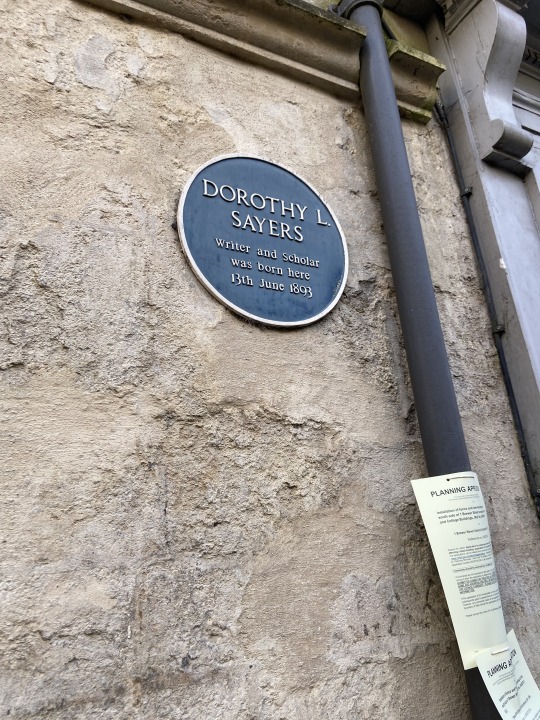

Whilst in Oxford, I also did a bit of homage-paying to Dorothy L Sayers—found Balliol on purpose, stumbled across her birthplace on accident. Both delightful!
143 notes
·
View notes
Text

More merms for the May! Wiz as a catfish, Fi as a nurse shark, and Nol as a tiger fish. Poses are from albanenechi and gonzais
#art#ocs#star trek au#wiz#sophia#Olivier balliol#I’m happy w the light in this one. Also fun fact. I hate drawing rocks#Mermaid#mermaids#mermen#mermay
19 notes
·
View notes
Text
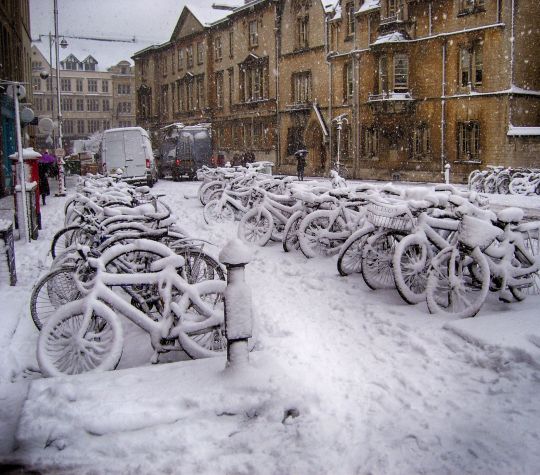
Winter lectures come first for Oxford students, despite the elements.
#Balliol College#Oxford University#bicycles#winter#England#English universities#academia#snowstorm#student life#UK
134 notes
·
View notes
Text
I WENT TO OXFORD
It was rainy but basically perfect- and now I have a question.
Anyway, first thing I did, while waiting for my Bodleian tour to start, was do the (very quick) "Harriet finally goes up like straw" walking tour, from the Broad Street gate of Balliol to New College Lane just past the Bridge of Sighs. It was excellent.
Below is the first photo I took- of the intersection of Broad Street and Catte Street (in my copy of the book spelled Cat Street), or the Holywell Corner, as Harriet calls it. This photo is how Peter and Harriet would have seen it, though presumably at night time (and I guess, potentially, on the other side of the street). From here, they'd cross ahead and to the right, and walk on the left side of Catte Street a few yards to New College Lane.
For those who like me have memorized the last page of this book- does anyone notice anything interesting?

I'll set the scene- they're walking back, and Peter drops that
'I have been afraid,' he said simply; 'because I knew that from anything you said to me here, there could be no going back.... But I will ask you now, and if you say No, I promise you that this time I will accept your answer. Harriet; you know that I love you: will you marry me?' The traffic lights winked at the Holywell Corner: Yes; No; Wait.
Wait what? What traffic lights?!
I can confirm, I walked on all sides of that intersection and couldn't find a traffic light or any indication that one had ever been there. No traffic light, no pedestrian stoplight, no nothing.
I have to assume that, however much Sayers might like metaphors and allegories and such, she wouldn't invent a traffic light for the sake of one. But maybe she did? Or maybe one did exist in 1935 and has been since removed in the name of some kind of renewal project? Is it related to the New Bodleian (now Weston) library being built starting in 1937 on that corner, or totally unrelated?
I'm not going to pretend that any of this matters, just say that a) I am always interested in things like this, whether they are important or not, and if anyone knows please tell me and b) it's a tribute to Sayers that so many of the scenes in the book felt so vivid that seeing the locations in person felt like returning to them- and that something feeling even slightly off from that could be jarring.
Bonus photo, to thank you for bearing with me- picture two Senior Members of the university closely and passionately embracing just past the bridge over there.

#dorothy l sayers#lord peter wimsey#peter wimsey series#harriet vane#gaudy night#oxford#besides the above I also saw the Radcliffe Camera (though sadly couldn't go up) and Christ Church (though sadly couldn't go in)#I did manage to see into the Christ Church gates though#and saw the fountain where Saint George proposed to feed the carp with Harriet's crushed meringues#oh also DLS's birthplace (across the street from CC) and the Balliol playing fields where she put Shrewsbury College#didn't make it to Somerville sadly- didn't have time#highly recommend Oxford as a city#though I do think it's probably a tad more fun when there isn't a flood watch
26 notes
·
View notes
Text
I wish more historical events had fandoms because I am hyperfixating on the Scottish wars of independence and the internet IS NOT pulling through
I know technically there is braveheart but no.
#braveheart#scotland#scottish history#the scottish wars of independence#john balliol#edward I#william wallace#alexander III#robert bruce#dont these tags show my desperation#history#fandom#please
10 notes
·
View notes
Text

John Balliol. English School.
After the death of Alexander III in 1286 and Margaret in 1290, John Balliol competed for the Scottish crown in the Great Cause (when the crown of Scotland became vacant in September 1290 on the death of the seven-year-old Queen Margaret, thirteen pretenders to the throne were presented), being superior in genealogical primogeniture but not in proximity of blood.
#kingdom of scotland#engraving#Rìoghachd na h-Alba#house of balliol#Kinrick o Scotland#Jhon Ballioun#Kongungdum Skotla#Iain Bailiol#king of scots#john balliol#Wars of Scottish Independence#john de baliol#royalty#scottish dna
2 notes
·
View notes
Text
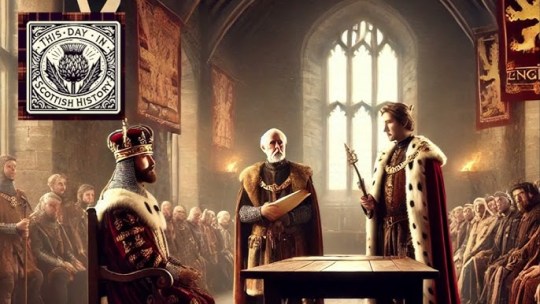

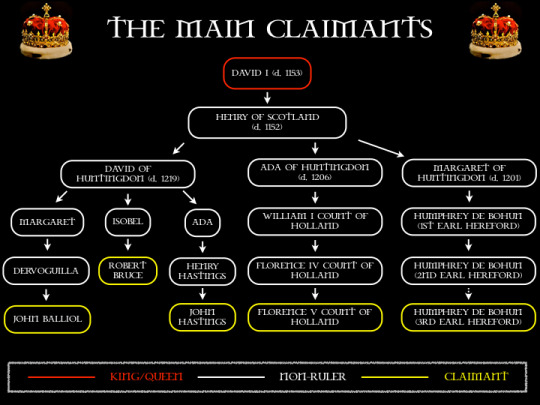
On 17th November 1292 John Balliol was awarded the Scottish Crown.
After Margaret, Maid of Norway had died in Orkney in 1290 Edward I was given the job of choosing Scotland's ruler, thirteen competitors put their names forward, and nine of the thirteen made the acknowledgement required by Edward. They also agreed that possession of the lands and castles of Scotland should be given to him so that he could pass them on to the rightful king, when the choice had been made. Hastings, all of whom were descendants of the three daughters of David, Earl of Huntingdon, grandson of David I.
After a further period for deliberation, Edward I awarded the crown to John Balliol, the descendant of the Earl's eldest daughter, in Berwick in 1292. In law, however, Robert Bruce's claim was equally good because, although he was descended from the second daughter, he was a generation nearer David I (as his grandson).
Balliol swore fealty to Edward I and on 26th December paid homage to him at Newcastle-upon-Tyne for the Kingdom of Scotland. When it became clear Edward I regarded Scotland as a vassal state, the Scots Nobles resisted and with Balliol agreed the "Auld Alliance" with France. On 5 April 1296 he renounced his fealty to Edward I, who marched north and defeated the Scots at the Battle of Dunbar. Balliol surrendered to Edward I on 10 July and his nickname "Toom Tabard" came from the removal of heraldic insignia from his coat to mark his submission. He was released in 1299 and retired to his French estate at Bailleul where he died in 1313.
What may surprise some people is the fact that Edward himself had a claim to the throne but did now pursue it, if you follow the line from Malcolm III and Queen (St) Margarets daughter Edith (Matilda) who married Henry I of England, I covered Matilda
15 notes
·
View notes
Note
Trick or Treat!
May I present Halloween-Cats Drawing hedgehogs, drawing bats. Altho' the season is demonic, These bats in fact are friends of Sonic.
3 notes
·
View notes
Text


st cross church, holywell, england - where Harriet Vane and Lord Peter Wimsey were married
#unfortunately locked and we didnt think to call ahead for access to uh. historical records for balliol that were definitely why we wanted to#see it and get in#but the GRAVEYARD beside it eas Very spooky and cool#sayers
6 notes
·
View notes
Video
youtube
👑 He wasn't just a king… he was the son of a puppet king. Betrayal, invasion, and a stolen crown — discover the rise of Edward Balliol and Scotland’s forgotten civil war. 👉 Watch “Son of the Puppet King: Edward Balliol’s Rise” now!
#king david ii#scotland#History#King#robert the bruce#medevil#1329#battle#edward balliol#civil war#rise#puppet#invasion#betrayal
0 notes
Text

The following accounts have reclaimed their roles. Please refollow:
Jasmine Harris - @jasminexharris
Nicole Balliol - @nicolexballiol
Wyatt Baxter - @wyattxbaker
0 notes
